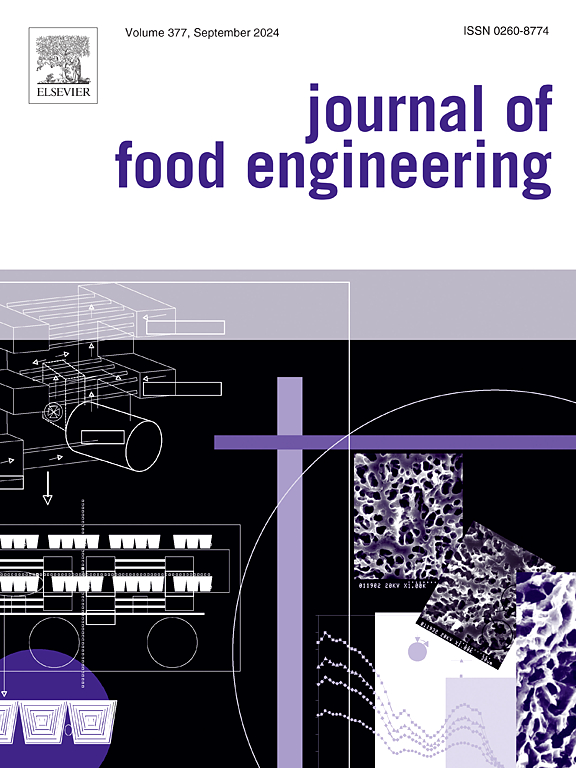通过超临界二氧化碳塑化提高胶原基生物膜的可加工性和力学性能
IF 5.8
2区 农林科学
Q1 ENGINEERING, CHEMICAL
引用次数: 0
摘要
牛胶原纤维的层次结构和高分子量,以及它们的广泛可用性,使这种动物蛋白成为生物膜生产的有希望的候选者。然而,与传统的热塑性塑料不同,胶原蛋白的加工具有挑战性,因为它具有复杂的分子内和分子间相互作用。本研究调查了超临界二氧化碳(sCO2)作为增塑剂的使用,在通过挤压成型形成薄膜之前的预处理阶段修改这些相互作用。试验了不同的超临界条件,评价了sCO2与常用增塑剂甘油(Gly)的复合效果。对预处理粉末和所得生物膜的微观结构分析揭示了一种非常规的塑化机制,其特征是三螺旋结构的丧失和随机交联网络的形成。这种效应在高温(80°C和80 - 300 bar)的超临界条件下尤为明显,胶原纤维表面水分的损失和变性纤维中官能团之间的相互作用导致可塑性增强。结果,挤压薄膜的刚度降低了20%,断裂伸长率增加了50%以上。相比之下,在较低温度和压力下(35°C和80 bar)的预处理只导致轻微的链断裂,保留了三螺旋结构,并产生了具有有限变形能力的刚性薄膜。这些发现表明,在胶原预处理过程中控制甘油存在的超临界条件是提高胶原基生物膜的加工性能和力学性能的有效策略。本文章由计算机程序翻译,如有差异,请以英文原文为准。

Enhancing the processability and mechanical performance of collagen-based biofilms through supercritical carbon dioxide plasticisation
The hierarchical structure and high molecular weight of bovine collagen fibres, along with their widespread availability, make this animal protein a promising candidate for biofilm production. However, unlike conventional thermoplastics, collagen processing is challenging due to its complex intra- and intermolecular interactions. This study investigated the use of supercritical carbon dioxide (sCO2) as a plasticising agent to modify these interactions during a pretreatment phase prior to film formation via extrusion-compression moulding. Different supercritical conditions were tested, and the combined effect of sCO2 and glycerol (Gly), a common plasticiser, was evaluated. Microstructural analyses of the pretreated powders and resulting biofilms revealed an unconventional plasticisation mechanism, characterised by the loss of the triple-helix structure and the formation of a randomly cross-linked network. This effect was particularly pronounced under supercritical conditions at higher temperatures (80 °C and 80–300 bar), where the loss of surface water from the collagen fibres and interactions between functional groups in denatured fibres led to enhanced plasticity. As a result, the extruded films exhibited a reduction in stiffness of up to 20 % and an increase in elongation at break by more than 50 %. In contrast, pretreatments at lower temperatures and pressures (35 °C and 80 bar) caused only minor chain scission, preserving the triple-helix structure and yielding rigid films with limited deformability. These findings demonstrated that controlling supercritical conditions in the presence of glycerol during collagen pretreatment is an effective strategy to enhance the processability and mechanical performance of collagen-based biofilms.
求助全文
通过发布文献求助,成功后即可免费获取论文全文。
去求助
来源期刊

Journal of Food Engineering
工程技术-工程:化工
CiteScore
11.80
自引率
5.50%
发文量
275
审稿时长
24 days
期刊介绍:
The journal publishes original research and review papers on any subject at the interface between food and engineering, particularly those of relevance to industry, including:
Engineering properties of foods, food physics and physical chemistry; processing, measurement, control, packaging, storage and distribution; engineering aspects of the design and production of novel foods and of food service and catering; design and operation of food processes, plant and equipment; economics of food engineering, including the economics of alternative processes.
Accounts of food engineering achievements are of particular value.
 求助内容:
求助内容: 应助结果提醒方式:
应助结果提醒方式:


